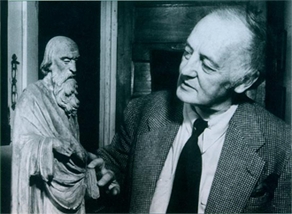Charles
Marius Barbeau
Erudite
Falklorist 1883-1969
An esteemed founder
of Canadian cultural anthropology – ethnologist, folklorist, and ceaseless
collector – Marius Barbeau made outstanding contributions to the understanding
and preservation of both Quebec and first peoples’ heritages in Canada.
His work on Quebec folk traditions, songs, and texts, however, would loom
larger. He was born in 1883 at Ste-Marie-de-Beauce on the Chaudière,
across the St. Lawrence from Quebec City, in what was certainly a bastion
of rural French-Canadian culture and, like many another academically promising
Canadien of that era, he studied for the Catholic priesthood but later
switched into law.
He excelled in law
at Quebec’s Laval University; in fact, he was chosen as a Rhodes Scholar
to attend Oxford University in the Anglo heart of the British Empire. As
an Oxford student in the early twentieth century, Barbeau was powerfully
attracted by the emerging discipline of anthropology and thereafter, with
a highly successful degree in anthropology, he was recommended to the young
National Museum of Canada which became his home base from 1911 to the late
1960s. In sum, over the half century that followed his return to Canada,
Marius Barbeau, with close to a thousand publications along with many more
renderings of folk songs permanently preserved at the Museum, was the dominant
figure in the recording of Quebec social and cultural traditions. While
sharing his own treasured store of artifacts and knowledge with the people
through books, popular lectures, and scholarly teachings, he also established
the Archives de folklore at Laval University. In these various ways, he
preserved vital work on the Canadien past.
 |
Marius
Barbeau worked at Canada’s National Museum for over one half century. When
he was a Rhodes Scholar at Oxford, he became interested in anthropology.
Viewed in this scene examining an early Quebec wood sculpture, Barbeau
was an enthusiastic collector of folk traditions germane both to rural
Quebec as well as Canada’s native peoples. A world-renowned ethnologist,
his much-respected name was given to the highest mountain in the Canadian
Arctic. Barbeau Peak rises to a height of 8,760 feet on Ellesmere Island.
[Photo, courtesy National Archives of Canada/PA-149993] |
With perseverance,
he examined as well the ethnoculture of Canada’s first nations, especially
in British Columbia where he gave particular attention to the Tsimshians
of the northwest coast. Here, with William Benyon, a noted hereditary native
chief, he built up an invaluable, ethnographic census. Even though Barbeau’s
own interpretation of Tsimshian tribal myths depicting a journey within
living memory from an ancient Asian homeland did not stand up to later
anthropological science, his pioneering work in his field nonetheless proved
invaluable in keeping alive old native memories of times long vanished.
Marius Barbeau –
eager, eloquent, and deeply learned – was important as a Canadian ethnoscientist
for well over half a century – in fact, until his death in 1969 when he
received warm tributes and honour for his own tireless journeying across
a widespread anthropological Canadian past. Today both academics and students
worldwide are indebted to the poignant legacy left behind by this prodigious
scholar of Canadian culture.
J.M.S. Careless